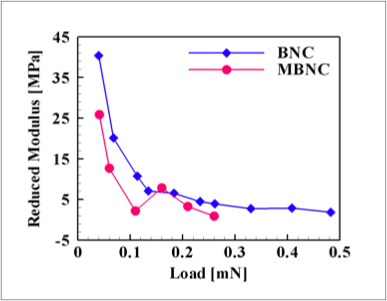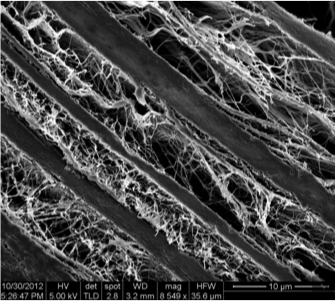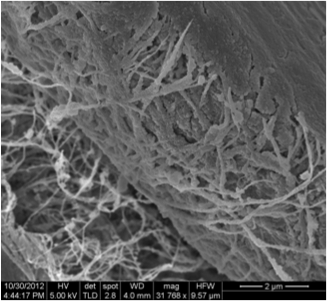In-situ studies of bio-nanomechanical behavior in a multi-functional hierarchical magnetic bacterial nano-cellulose (MBNC) membrane
Advanced biointerfaces can be achieved due to new chemical and/or nano-structured modulated surfaces that allow manipulation of biological environment at molecular level. Surface nanostructuring of conventional and advanced biomaterials is one of the keys to promote tissue growth, repair and regeneration, through favorable interactions with both cells and surrounding biological species. Our global hypothesis is based on exciting results obtained by our team, confirming the ability of directed irradiation synthesis (DIS) to tailor the functionality of biocompatible surfaces. Therefore, the aim of this theme is to modify the structure and/or chemistry of surfaces to produce designed nano-structures and controlled chemical species with specific target on cells stimulations mediated by designed new biointerfaces.
Highlight: In-situ studies of bio-nanomechanical behavior in a multi-functional hierarchical magnetic bacterial nano-cellulose (MBNC) membrane
Surgical clipping and endovascular coiling are well recognized as conventional treatments of penetrating Brain Injury (PBI) aneurysms. These clinical approaches have seen partial success, but often result in thrombus formation and the rupture of aneurysm near arterial walls. We are addressing these challenging brain traumas with a unique combination of highly biocompatible biopolymer and magnetic nanoparticles in a flexible and resilient membrane coating integrated to a scaffold stent platform at the aneurysm neck orifice.
We are studying the in-situ nano-mechanical behavior of bacterial nanocellulose (BNC) membranes in an aqueous environment used as tissue reconstruction substrate for cerebral aneurysmal neck defects. The multi-functional membranes are impregnated with biocompatible magnetic nanoparticles (MNPs) to render the BNC magnetic. Nano-scale response of BNC behaves similar to a viscoelastic solid with a very low Young´s modulus, E (0.0025 GPa to 0.04 GPa), and an evident creep effect. Elastic and viscoelastic properties of both BNC and MBNC presented a suitable match with reported mechanical properties of blood vessels, which confirms the promising potential of these new advanced functional bio-nanomaterials to be used as endovascular in-situ reconstruction alternatives.
Global scheme of In-situ nano-mechanics study of hydrogel bacterial nano-cellulose (BNC) and magnetic BNC (MBNC).
In-situ nanomechanical properties of bacterial nano-cellulose (BNC) and magnetic BNC (MBNC): nano-elasticity behavior of samples (left); hierarchical structure of hydrogel samples (middle); a higher fiber and magnetic nano-particles (MNP’s) densities in the outer zone of the samples.
Sponsors
Department of Defense, U.S. Army Medical Research and Materiel Command, Fort Detrick, Maryland 21702-5012, Award Number: DM090909 (W81XWH-11-2-0067)
People
Sandra Arias
Juan J. Pavón



